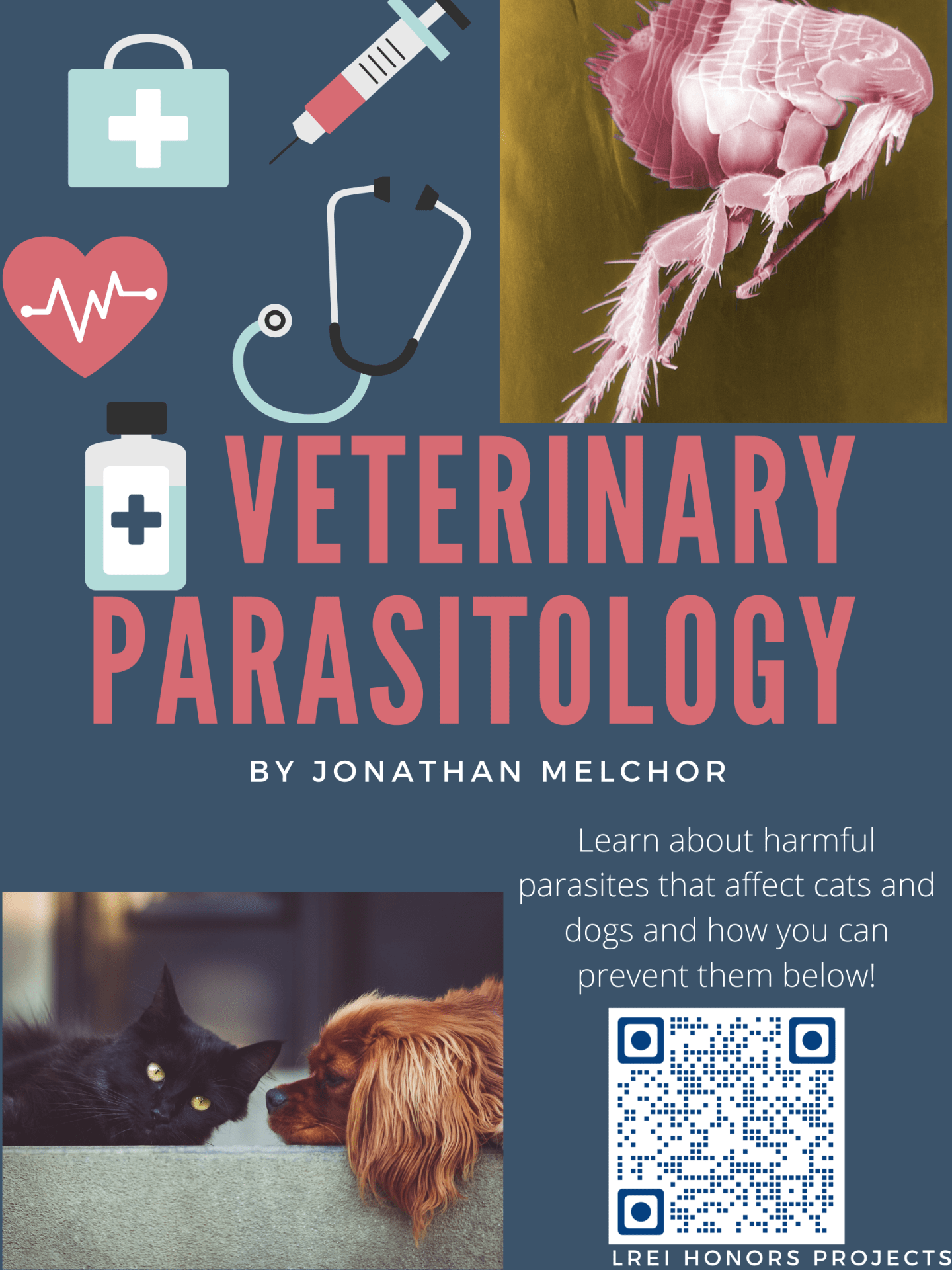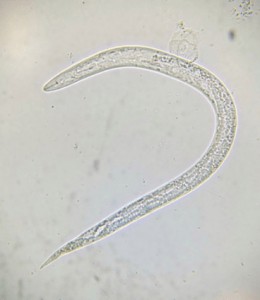Project by: Jonathan Melchor (10th Grade)
Project Advisor: Kara Luce
Student(s)’s Advisor(s): Susan Now
Description of the Project: This Honors Project will focus mainly on the parasites that are commonly found in cats and dogs, the most common pets. It will focus on the life cycle of a parasite, the anatomy of a parasite, how and why these parasites affect their hosts, and how they can be prevented. I will create a scientific video showing images of these parasites and will be verbally explaining these topics.
Final Product (e.g., documents, images, video, audio, poster, display, etc.):
I attached the video to my Honors Project below! Enjoy! 🙂
Final Reflection on Learning:
I honestly had an amazing time researching about parasites and learning about them. Parasites are often terrifying to think about and learning about how parasites function and live cleared up tons of confusion that I had earlier. I aspire to become a veterinarian and this Honors Project felt like an amazing starting place. Researching and creating the video mad me feel like I was a veterinarian teaching pet owners about parasites and how to make sure their pets are healthy. I have a long journey ahead of me and I do not plan on stopping on this project alone. Hopefully I can do more veterinary Honors Projects in the future and continue to teach myself and LREI about the health of their pets. Being able to pursue my passion towards animals at school through this Honors Project felt rewarding and informative. I want to thank Kara Luce for mentoring me through this Honors Project and for being an amazing mentor who provided me with some online resources and made sure I was keeping up with everything. Thank you all so much for reading through my Honors Project page and I hope you enjoy the video. Have a great day and hopefully I will see everyone again next trimester! Adios!
Jonathan
Update on Progress from Weeks 1-3:
Nematodes!
This week I decided to read the beginning chapters of a veterinary parasitology textbook. I looked into the life stages that a roundworm or nematode goes through starting from the egg to becoming an adult. The eggs of a nematode consist of three chemical layers: An inner layer that has a lipid-like membrane that does not allow any fluids go through, second or middle layer that is very tough, thick, and made of a nitrogen-containing carbohydrate known as chitin that is somewhat transparent, and lastly a third layer made up of proteins that are thick and sticky and essential to the strength of this wide spreading parasite. The eggs hatch outside of the body of a host or through ingestion when the parasite enters an exposed and vulnerable host. The moisture and temperature within a host is perfect for the eggs to hatch. When the host ingests these eggs, it stimulates the eggs to hatch and the larvae wriggles and uses enzymes to break free from the egg and it immediately begins to absorb the moisture and carbon dioxide from its environment (usually in the gut).
The first two stages of larvae feed on any bacteria they are able to come across but the third stage of larvae wrap themselves in a cuticle or barrier so it cannot eat any bacteria so it must rely on its stored nutrients. Higher temperatures and higher humidity levels help these larvae develop a lot quicker and easier. When the stage 3 larvae are ready, they use their own fluids that contain enzymes to wiggle free out of their cuticle.
The beginning stages of the grown nematode have an aerobic metabolism which means they are able to store and create bodily energy through combustion of carbohydrates, amino acids, and fats or lipids in oxygen. That means that these nematodes absorb large amounts of oxygenated nutrients from the host in order to survive. This aerobic metabolism process ends with carbohydrates and fats released through the anus of the nematodes. The more nematodes there are means that there would be more nutrients taken from the host. This leaves the host feeling ill and weak.
Update on Progress from Weeks 4-6:
I have been researching and reading more information on the different kinds of parasites found in cats and dogs, signs of these parasites within these animals, and some of the different ways to prevent these parasites. To start with, I went to look at the most common parasites that veterinarians look for which include tapeworms, heartworms, mange, and fleas.
Tapeworms are parasites that can be found in the small and large intestine and they are transmitted into the body through fleas. Flea larvae are often infected with a tapeworm and when a cat grooms itself or if a cat or dog bites its coat due to the itchy fleas, these tapeworms enter into the digestive system of the animal. Signs of weakness, weight loss, and vomiting up tapeworms are the most common signs of tapeworms. Medications and treatments are available for both fleas and tapeworms and pet owners properly and consistently grooming their pets and checking for fleas is the best way to prevent these parasites.
Heartworms are parasites that are transmitted by mosquitos into the bloodstream of cats and dogs. Heartworms live in the lungs, heart, and blood vessels of both cats and dogs. Heartworms are more commonly found in dogs rather than cats but these parasites can cause sever lung disease, heart failure, and can damage other organs in both of these animals. Taking cats and dogs to a veterinarian at least yearly for heartworm examinations are the best way to spot these heartworm. Giving these animals heartworm prevention pills throughout all seasons and monitor your pet to make sure they are exposed to very little to none mosquitos. Heartworms symptoms include, fainting, weakness, low energy levels, heart failure, change in appetite, and breathing difficulty. It is important to treat heartworms as soon as possible so that the symptoms do not get progressively worse and so that these symptoms do not become fatal.
Mange is the final parasite I looked at and they are usually spotted on the skin of the animal . They cause skin irritation and discomfort for dogs and cats to the point where these animals may scratch pieces of skin off. They can be transmitted to humans but they do not thrive in humans as well as they do in dogs and cats. They can cause skin disease. If a dog or cat is positive for having mange, it is necessary to remove all surfaces, toys, blankets, and beds that could also be contaminated with mange. Keeping dogs and cats in a clean environment, healthy, and maintaining a healthy diet can help prevent mange. Veterinarians can offer extra medications for prevention of these parasites as well.
There are some general rules to follow in order to prevent other parasites from entering the body of cats and dogs:
- Do not feed the cats and dogs raw food. Raw food is more likely to contain living parasites and consumption of these food is the easiest way for the parasites to end up in the small intestine.
- Take your animals to the veterinarian yearly or more frequently. They can do heartworm examinations, do examinations of the feces of the animal to look for any parasites, and they can offer lots of medications and treatments so that the pet can be free from these parasites. They can prevent fleas, ticks, mites, and any parasitic worms that may be living in the animal.
- Picking up after your animal’s feces helps prevent parasitical contamination of that feces. Usually dogs will smell each others feces when going on a walk and that is the opportunity for when the parasites enter the dogs body. The same applies for cleaning a cat’s litter box.
- Look for parasite signs early so that they don’t intensify later. Some signs are very noticeable and include constant itching, vomiting, visible parasites in feces, signs of weakness, and any rashes.
Lastly, after finishing studying these parasites, I will be developing a quick, entertaining, and educational video on parasites to close this Honors Project. That’s it for now and I will keep updating and working towards the final product. Thank you!
Update on Progress from Weeks 7-9:
After weeks of gathering information on parasites, I created a script where I would talk to everyone about my findings. I made a voice recording and recorded myself drawing in order to keep the video a little engaging and somewhat pleasant to look at (despite my terrible drawing skills). Using my prior and highly developed editing skills, I was able to create the final product video. This video is inspired by the YouTube channel ASAP Science where they make fun and informative scientific videos while drawing out their characters and pictures relating to what they are saying. This video will start from weeks 1-3, where I learned the life cycle of a parasite, and end on weeks 4-6, where I learned about the different kinds of common parasites found in dogs and cats and ways on how to prevent these parasites from living in our loveable pets. This was very difficult and time consuming so I hope you will all enjoy! Thank you!


